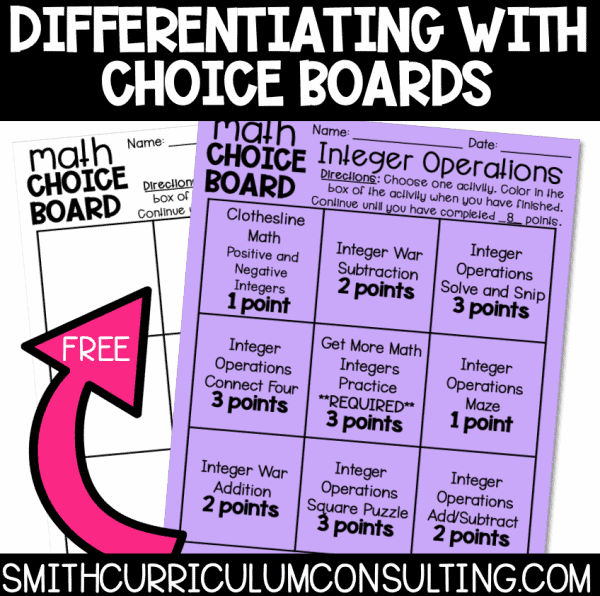
When I wrote the original post about Changing Students Thinking About Math, I never realized the feedback that I would get. Not only did I receive comments but also had emails and people asking me questions on my Facebook Fan Page. Wow, I hit a topic that people wanted more info about!
I decided to not respond right away because I wanted to plan things out and really make this a series of blog posts (currently a total of 5 are planned) and make it full of information for you to use to make a difference in your classroom.
So…. How do you go about finding gaps in your students thinking so that you can build a solid foundation of skills?
1. Assess! Yep, it’s the root of all evil to assess students over and over again but it must be done to determine if what you are teaching, or what has been taught, has stuck with them. Now when I talk about assessment I don’t always mean paper and pencil assessment. Heck, I don’t even always mean computer based assessment. You as the teacher are allowed to determine what assessment best fits the skill that you are teaching in your classroom. Yep, I give you permission. (Now, I know we all have to give school/district assessments as well but that’s another day and another story.)
Informal assessment can be anything from having a student do some practice problems, to orally explaining a process to you, writing in response to an open-ended response question (gotta love Post-It, Prove Its), CGI word problems that they can journal about and more. It doesn’t end there!
How do you know when to assess? Well, I found this amazing flow chart that I think is just the bees knees (yep, I said that!) over on C.Jayne Teach. Jump on over to her TpT store for a FREE printable copy of this and KEEP IT handy!
2. Talk! Yes, sometimes it is a simple as building that relationship with your students on a one-on-one basis and just talking to them. When they have developed the level of trust with you because of building that relationship they will share with you their struggles.
Myles was one of my most stubborn students. He hated coming to my class because I was hard on him. I made him come to class with his notebook, his pencil and without his backpack (school rule). I made him get his papers as he walked in the door that he would need for the day. I made him not talk to his friends as he was preparing for class and getting his Interactive Notebook ready for the day. I made him keep his head up off his desk during the class period when he got frustrated. I made him answer questions randomly.
I didn’t make him come to tutoring, his reluctance to do homework made him come to tutoring because he wanted to play football. Myles hated tutoring because it meant he had to work or I kicked him out and I would follow through by letting his coach know. Myles knew that telling coach meant running laps and possibly not playing in that week’s game.
After serious conversations with Myles about the important of learning so that he could not only play in the game each week, Myles started coming to tutoring outside on Friday mornings (I had car duty) and sitting with a group of about 5-10 students who were getting last minute homework help because it was due that day. You know what, Myles started to talk to me. He started to tell me where his weaknesses were just by the questions he asked and because of this I was able to ask him to start coming to my after school tutorials where we played games. Myles didn’t know that those games were going to help him be a better math student. Myles came with reluctance but after the first session, he was hooked. Myles now keeps in contact with me regularly and enjoys math.

This is Myles in my classroom last year playing a game that not only taught him about ratios but helped fill his gaps on equivalent fractions, factors, multiples and basic multiplication facts.
3. Track and Analyze! This is probably the most boring of the three things I will share with you today but also probably one of the most important. Tracking data for each student (not just the class or your entire group of students) will help you as a teacher determine weaknesses and strengths not only in your teaching but also in your students learning.
In my classroom checklists, like these created by MissMathDork for Common Core, and my handy-dandy clipboard were my best friend. I could go through and mark the skills that students were mastering and keep dates of when it was tracked all in one location for each student.
There were also times where I would print out a class roster and use it for documentation purposes for a certain skill. Many times as I was looking at their Post It, Prove Its or Exit Tickets at the end of a day I would easily be able to mark whether a student has mastered a concept, needed a bit more practice, needed more instruction and practice, or needed a complete reteach of the skill. It was that simple to help differentiate my next days lessons in my classroom.
(More on tracking and analyzing is coming soon, I promise! This blog post has spurred some great ideas.)
I won’t say that this came to me in my first years of teaching but rather took until about my 7th year of teaching to even start doing this. Now after two years of starting to put it in here and there I saw the value of these methods in my classroom. I started to fill in those gaps that my students had from prior grades. Did it matter what caused those gaps? Nope. Was I going to dwell on it and make excuses? Nope. I knew I was at a crucial point in a students math education where if they didn’t master some of the critical skills they were going to be SUNK in high school.
If you have made it this far, thank you because as you can see I had a lot to say on this topic and I only gave you three tips. Now comes my call to action…
What can you do in your classroom tomorrow to help change how you fill in the gaps for one student, a small group of students, or even all of your students?




